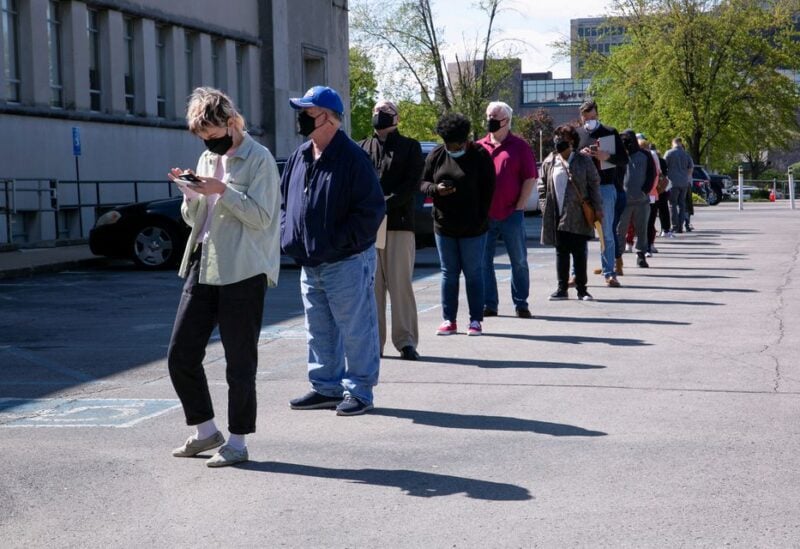
People line up outside a newly reopened career center for in-person appointments in Louisville, U.S., April 15, 2021. REUTERS/Amira Karaoud
Fewer Americans filed new claims for unemployment benefits last week as the labor market steadily recovers from the COVID-19 pandemic amid a reopening economy, but a dearth of willing workers could hinder faster job growth in the near term.
The economy appears to be at cruising speed more than half way through the second quarter, with other data on Thursday showing strong growth in business spending on equipment in May. While the goods trade deficit widened last month, that was because of an increase in imports as businesses desperately try to keep up with robust demand. Warehouses at retailers are almost bare.
“It looks like the economy continues to astound us with the speed and strength of the recovery from what is turning out to be the quickest recession in history,” said Chris Rupkey, chief economist at FWDBONDS in New York.
Initial claims for state unemployment benefits fell 7,000 to a seasonally adjusted 411,000 for the week ended June 19, the Labor Department said. Data for the prior week was revised to show 6,000 more applications received than previously reported. The first increase since late April was blamed by economists on volatility in the aftermath of the May 31 Memorial Day holiday.
Economists polled by Reuters had forecast 380,000 applications for the latest week. There was a surge in claims filed in Pennsylvania last week, which was offset by sizeable declines in California, Florida and Illinois.
Claims have dropped from a record 6.149 million in early April 2020, but are still above the 200,000-250,000 range that is viewed as consistent with a healthy labor market.
They remain elevated despite 12 states with Republican governors, including Iowa, Mississippi, Alabama and West Virginia, pulling out of federal government-funded unemployment programs, including a $300 weekly check, which businesses complained were encouraging the jobless to stay at home.
People seeking government-funded benefits must first file a claim for the regular state unemployment insurance to determine eligibility. Thirteen other states, including Texas, Georgia, Maryland and Florida, will end these benefits for residents between June 26 and July 10. Louisiana is ending the weekly supplementary check on July 31, the only state with a Democratic governor to terminate federal benefits. For the rest of the country, they will lapse on Sept. 6.
At least 150 million Americans have been fully vaccinated against the coronavirus, allowing the economy to begin reopening. But millions of workers remain at home, frustrating employers who are urgently seeking help to meet surging demand as people leave their homes after being cooped up for more than a year. There are a record 9.8 million job openings.
A shortage of childcare facilities is keeping some parents, mostly women, outside the labor force. Some people also are hesitant to return to work out of fear of contracting the virus. Pandemic-related retirements and transitions into new careers are factors as well.
“We think the labor market will keep recovering over time,” said Daniel Silver, an economist at JPMorgan in New York. “But filings can be impacted by a range of different factors and we think the data could be particularly noisy now that some states have started reducing the programs available for benefits and more states plan to do this in the coming weeks.”
U.S. stocks opened higher. The dollar was steady against a basket of currencies. U.S. Treasury prices were mostly higher.
STRONG GROWTH
Federal Reserve Chair Jerome Powell told lawmakers on Tuesday that he believed the economy would see strong job creation in the fall. In addition to the brightening public health situation, trillions of dollars in pandemic relief from the government are underpinning the economy.
In a separate report on Thursday, the Commerce Department said shipments of non-defense capital goods excluding aircraft, a closely watched proxy for business spending plans, increased 0.9% last month after advancing 1.0% in April.
Core capital goods shipments are used to calculate equipment spending in the government’s gross domestic product measurement. But supply constraints could be slowing momentum.
“As supply issues remain very prevalent, it will be important to watch various indications of demand over the coming months for any more concerning signs that lack of supply could be discouraging demand,” said Veronica Clark, an economist at Citigroup in New York.
Strong demand and tight supply are forcing businesses to turn to imports, boosting the trade deficit. In a third report, the Commerce Department said the goods trade deficit increased 2.8% to $88.1 billion in May. While inventories at wholesalers rose 1.1%, stocks at retailers dropped 0.8%. That mostly reflected a 5.3% decline in inventories of motor vehicles. Auto production has been hampered by a global semiconductor shortage.
The swelling goods trade deficit and falling retail inventories did little to change economists’ robust GDP growth expectations for this quarter, with estimates around a 10% annualized rate. The Commerce Department confirmed in a fourth report that economic growth accelerated in the first quarter, thanks to the massive fiscal stimulus.
GDP increased at a 6.4% annualized rate last quarter, unrevised from the estimate published last month. The economy grew at a 4.3% rate in the fourth quarter.